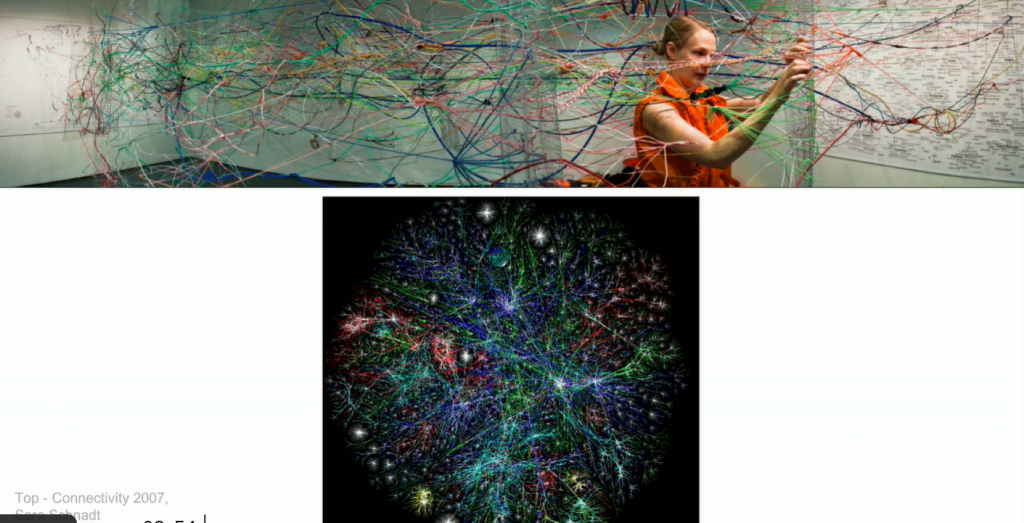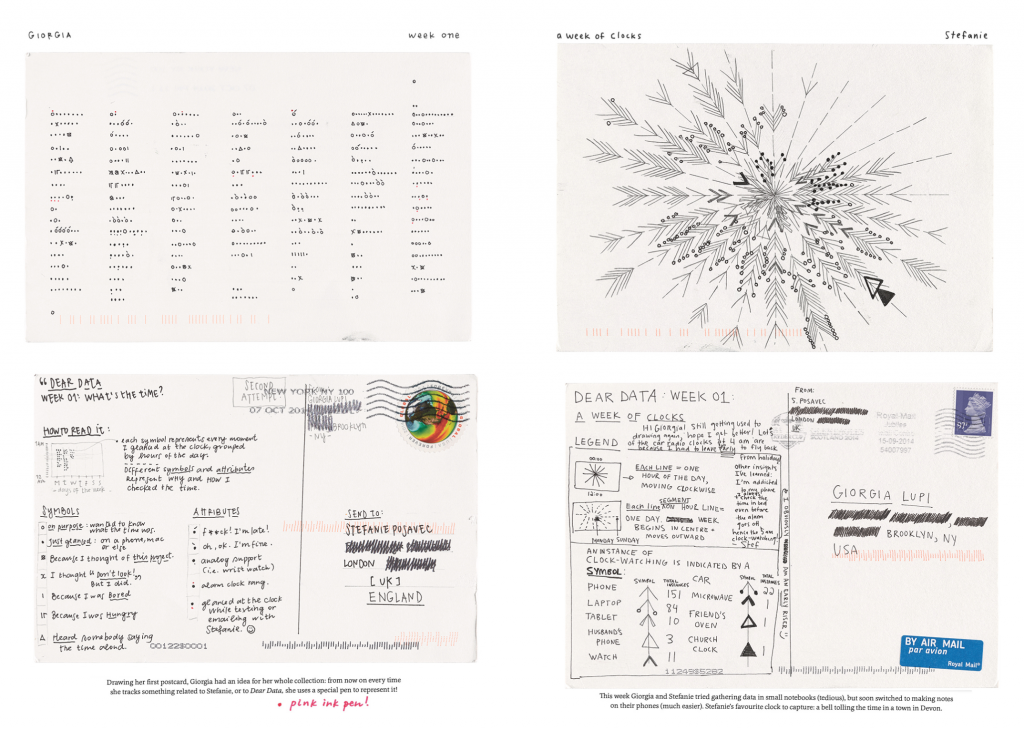Nicole Aptekar is a sculpture that went through different media and found her calling in digital fabrication through laser cutting. With experience in various ways of fabrication, Aptekar challenges the boundaries of shapes and voids relationships to develop interesting forms that tell her artistic intentions. Aptekar uses codes and scripts in a Rhino compatible software called grasshopper to push the limits of the abstraction of the shapes she’s developing. Her coding allowed her to develop her workflow and refine her bodies of work more easily in the long term. Aptekar’s “It’s no longer safe here” took over her body of work and she struggled to top that piece; that lead her to develop new tools to help reinvent her style. I really admire her constant drive to rework her pieces and explore new shape relationships. During the presentation, I really appreciated the use of sound that accompanies her work. I think that brings a new dimension to her art.
http://nicoleaptekar.com/
Category: LookingOutwards-08
LookingOutwards-08
One of the talks I watched for this week’s looking outwards is Adam Harvey’s (link to his site: https://ahprojects.com/) Face Recognition and Datasets (https://vimeo.com/354276111). He is an American artist and researcher who graduated from the Interactive Telecommunications Program at New York University and previously studied engineering and photojournalism at Pennsylvania State University. His work involves camouflage from face recognition and camouflage from thermal cameras, and he is based in Berlin. He did a wifi geolocation spoofing project and also used computer vision software for a company called Syrian Archive, to detect illegal ammunition with scannable synthetic data. Another one of his projects is MegaPixels, which uses data sets to build algorithms. One concept he discusses in his talk is “media in the wild” which means that no one knows who’s own facial information is in the data set, and who’s features may be included for facial recognition software. I found that to be interesting and mysterious to think about. Furthermore, the way that Harvey presents is powerful because he uses many visuals and graphics. His pacing is clear and spoken in simple terms for people to understand. In my presentations in the future I want to apply some of these skills of being clear and concise as well.
LO 8
Sara Hendren is an artist, researcher, and professor based in Cambridge, Massachussetsin Colledge of Engineering. She is a self-described “humanist in tech” who focuses on the human body and the politics of disability.
My interest in Hendren was spark because of my current studies in design; the major requires us to take design theory/research classes that include design for equity and inclusivity. Design for disability is something that has been discussed in passing and seeing Hendren’s work focused on research and design for disability is a wonderful way to see disability-focused work outside of the classroom.
I particularly enjoyed seeing her project on dancing wheelchair ramps, a project constructing a series of ramps into a stage for Alice Sheppard to dance on. The project was worked on in collaboration with a physics class to study and work with the ramp’s affordances for choreography.
Sara’s presentation takes us not from an idea to a finished product, but the opposite, showing us the final project, and slowly working backward to its inception.
08_LO_creativePractice
For this week’s topic, I watched the talk of Christina “Phazero”Curlee about “ from Video Art to Video Game”.
Christina is from a self-taught traditional fine art background and put her interest in art, interaction, game design and programming. She blends different principles of game and art in order to find her own vision in game style. Her work heavily demonstrates symbol and non-verbal experiences.
The purposes of her art mainly focus on communicating with people and facilitate interactions. During her art journey, she tried many things, like painting, installation art, photography, video art and video games.
The way I admire her is about her way to treat her anxiety, depression and stress. She uses video games as a way to communicate with others and she describes game design as setting a room and welcoming people to start a conversation.
She uses video game or video game media to discuss some serious topics which are hard to describe in some other situations, like multisensory interactive experiences, space and human bilateral influences, etc.
Even during the recent day, the game industry, especially the indie game area, has witnessed huge change and improvement. A lot of people still tend to think video games are undesirable things for humans, especially for kids. I would like to see more artists to use video game as a tool to prompt active communication and use the trait of video games in a positive way to inspire other people.
Eyeo 2019 – Christina Phazero Curlee from Eyeo Festival on Vimeo.
LO-08
I watched the video of Lauren McCarthy, a Los Angeles artist who explores ideas around social relationships, surveillance, and the rapidly changing technological field that is our modern world. She has created numerous art pieces looking into the intricate and ever developing relationship between social and technological systems.
What interested me most about Lauren’s talk is her exploration into the constant surveillance that modern citizens live with. Through her projects, she begins to ask questions about how changing technology has affected what it means to be “followed” or “watched.” My favorite work that she talked about was called “Follower,” and it was a conceptual “social media” app in which the user signs up to be silently and invisibly followed for a full day. This piece explores the relationship we have with technology by using an analogy with romantic human relationships, bringing to the surface the root of the conflicting comfort and discomfort we feel as we play the role of an actor in an everyday performance.
LookingOutwards-08

Anouk Wipprecht is a Dutch-based fashion tech designer who works in the emerging field of electronic wearable installation, a combination of visual designs and interactive technology. Her project “Spider” employs microcontroller such as sensors and moveable joints to make the garments move and breathe with the wearer’s actions. Wipprecht researches on how machine learning and biomimicry are able to manipulate the texture and the function of daily outfits. By partnering up with tech companies such as INTEL, Autodesk and Audi, she fuse futuristic concepts into high fashion and evoke the audience senses towards their surroundings. In the project, she extracts the parking sensors from Audi cars to put on the clothes with geometric design elements, putting more focus on shape, look and feel of things into mechanical object while empowering the wearer with its functionality.
Artist Website: http://www.anoukwipprecht.nl/about-me-shift#bio
Looking Outwards 8

Sara Schnadt is an artist who also works in multiple other fields as UX designer and software systems architect. She currently is a designer at NASA Jet Propulsion Laboratory and is working for the software human interface design and system architecture for machine learning for the Europa Clipper mission. I was intrigued by her work primarily because of the scope, scale, and ambitiousness of the projects she is involved in. Sara Schnadt talks about how her work NASA inspires her installation works and vice versa because she finds many similarities between the creative processes of both practices. Schnadt emphasizes that although space projects involve a lot of technological skills and are more engineer based, when the projects are thought of as also creative projects and design problems, it opens up more possibilities and complexities.
LO-08
Yuri Suzuki is a London based designer who works with sound. Before getting into design and technology, Suzuki was a musician and a DJ. When he started to get into design, he wanted to keep his musical background in his career, so he got into sound design. He is now a partner at Pentagram, which is the largest independently owned design studio in the world, and is also on faculty at the Royal College of Art in London.
Suzuki’s work makes people think about how they perceive sound in the world around them. One of my favorite projects that he introduced in his presentation was the Sound of Earth. The project is a large black globe with grooves that mimic the Earth’s topography. A needle plays the globe like a record and as it passes over each country, it plays sounds and music that Suzuki recorded on his phone while visiting the country.
Suzuki’s presentation is a brief overview of several of his projects. He introduces the project, then shows a video to demonstrate it. The video component was definitely an effective presentation method because he covered so many projects that there is no way that he can bring them to his presentations. Each overview was so brief that I don’t feel that I got an amazing idea of the process behind each piece through the presentation, but it certainly gives the viewer a great idea of the scope of his work.
Yuri Suzuki’s website can be accessed here: https://yurisuzuki.com/
Suzuki’s presentation at the Eyeo Festival (2015)
LO – 8
I found the information designer Stefanie Posavec very inspiring — she spoke at Eyeo in 2018. With roots in communication and graphic design studying in various American colleges, Stefanie is now based in London and is most known for exploring non-traditional representations of data across a variety of mediums. Her ability to translate data (collected from her personal life and for the service of various enterprises who commission her) into consumable visual pieces of art and design is very interesting to me as it is both visually appealing and accessible to more people than traditional fine arts. In this way, she is both an artist and designer, solving problems through translating data while instilling her personal vision and at times, using data from her personal life.
I find all of Stefanie’s work interesting, but I really enjoyed one of her most notable projects Dear Data, where she and English designer Giorgia Lupi sent each other hand-drawn postcards visualizing data collected over their everyday lives, over the course of a year. The analog format of these data visualizations really strip away the complexity that many associate with code. Even without code, information can be communicated in an elegant, concise way. I wish to continue exploring Stefanie’s work to continue incorporating my artistic voice into pragmatic and interesting solutions.

Looking Outwards – 08
Lindsay Grace is a video game designer, artist, and a professor. He’s best known as an academic gamer because of his focus on uses of interactive media and games to not only explore worlds but also cultural standards. His work includes projects such as social impact games, which are games that try to affect the gamers perspective about an issue, and much more. I think what he does effectively in his presentation is draw from different projects he’s worked on and the true data he shows with it.
![[OLD FALL 2020] 15-104 • Introduction to Computing for Creative Practice](https://courses.ideate.cmu.edu/15-104/f2020/wp-content/uploads/2021/09/stop-banner.png)